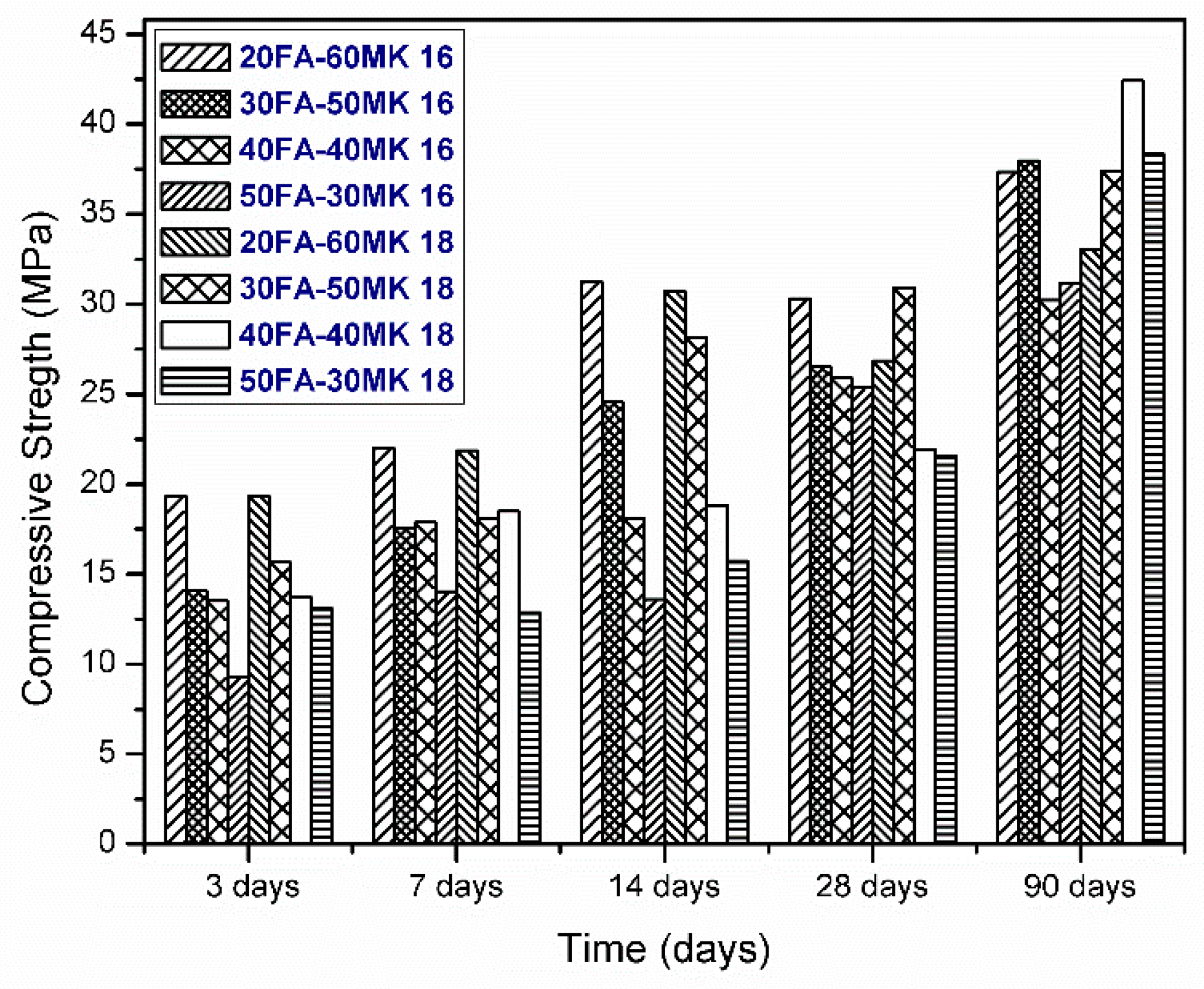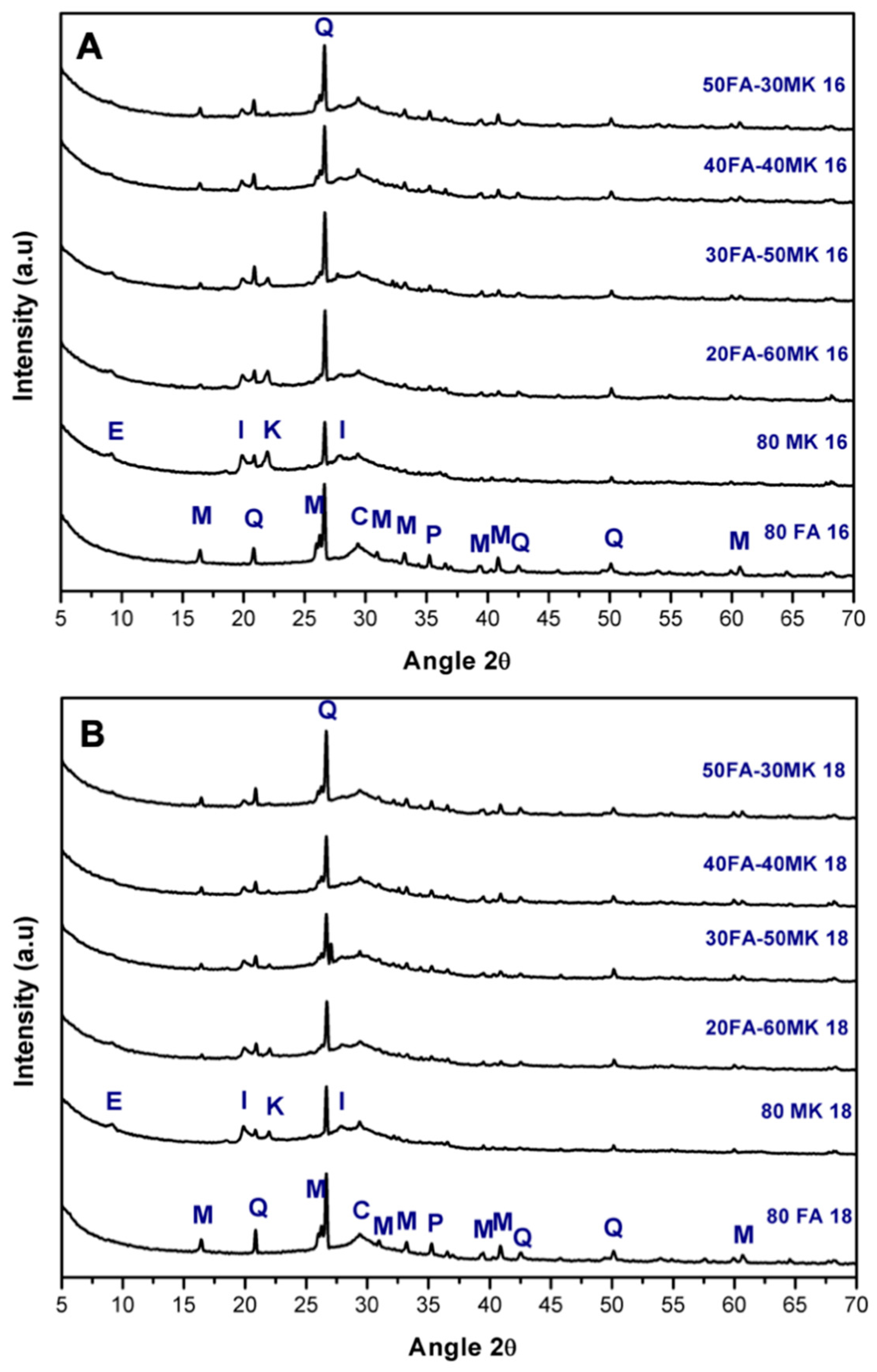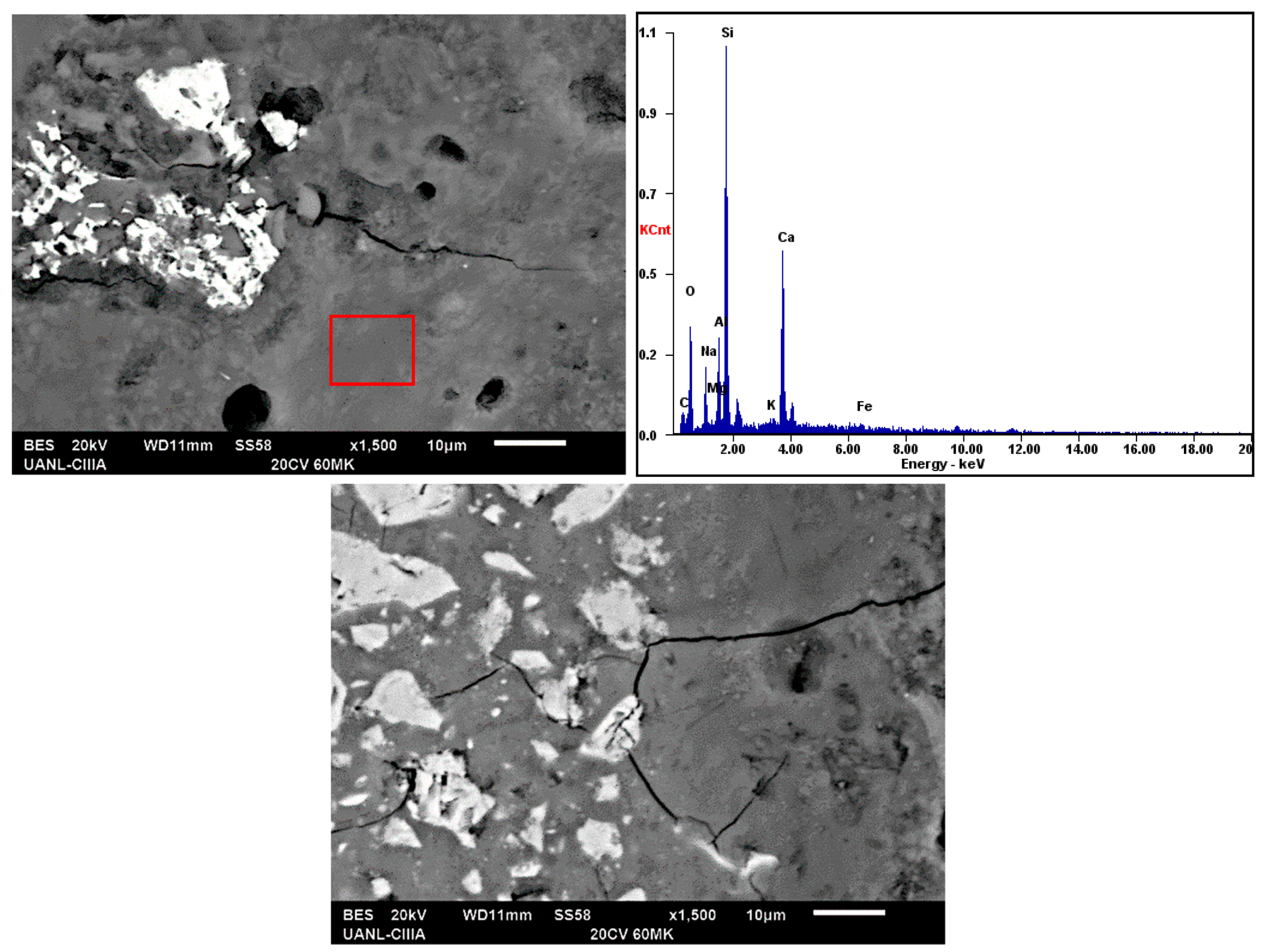Synthesis and Characterization of a Hybrid Cement Based on Fly Ash, Metakaolin and Portland Cement Clinker
Abstract
1. Introduction
2. Materials and Methods
3. Results
3.1. Compressive Strength
3.2. X-ray Diffraction
3.3. Fourier Transformed Infrared Spectroscopy
3.4. Scanning Electron Microscopy
4. Discussion
5. Conclusions
Author Contributions
Funding
Acknowledgments
Conflicts of Interest
References
- García-Lodeiro, I.; Fernández-Jiménez, A.; Palomo, A. Cementos híbridos de bajo impacto ambiental: Reducción del factor clinker. Rev. Alconpat 2013, 3, 161–176. [Google Scholar] [CrossRef]
- Torres-Carrasco, M.; Puertas, F. Alkaline activation of different aluminosilicates as an alternative to OPC: Alkali activated cements or geopolymers. Rev. Ing. Constr 2017, 32, 5–12. [Google Scholar] [CrossRef]
- Ke, J.; Mcneil, M.; Price, L.; Khanna, N.Z.; Zhou, N. Estimation of CO2 emissions from China’ s cement production: Methodologies and uncertainties. Energy Policy 2013, 57, 172–181. [Google Scholar] [CrossRef]
- Ludwig, H.M.; Zhang, W. Research review of cement clinker chemistry. Cem. Concr. Res. 2015, 78, 24–37. [Google Scholar] [CrossRef]
- Lothenbach, B.; Scrivener, K.; Hooton, R.D. Supplementary cementitious materials. Cem. Concr. Res. 2011, 41, 1244–1256. [Google Scholar] [CrossRef]
- Fernández-Jiménez, A.; Puertas, F.; Sobrados, I.; Sanz, J. Structure of calcium silicate hydrates formed in alkaline-activated slag: Influence of the type of alkaline activator. J. Am. Ceram. Soc. 2003, 86, 1389–1394. [Google Scholar] [CrossRef]
- Duxson, P.; Fernández-Jiménez, A.; Provis, J.L.; Lukey, G.C.; Palomo, A.; van Deventer, J.S.J. Geopolymer technology: The current state of the art. J. Mater. Sci. 2007, 42, 2917–2933. [Google Scholar] [CrossRef]
- Fernández-Jiménez, A.; Palomo, A.; Sobrados, I.; Sanz, J. The role played by the reactive alumina content in the alkaline activation of fly ashes. Microporous Mesoporous Mater. 2006, 91, 111–119. [Google Scholar] [CrossRef]
- Palomo, A.; Alonso, S.; Fernandez-Jiménez, A. Alkaline activation of fly ashes: NMR study of the reaction products. J. Am. Ceram. Soc. 2004, 87, 1141–1145. [Google Scholar] [CrossRef]
- Garcia-Lodeiro, I.; Palomo, A.; Fernández-Jiménez, A. An overview of the chemistry of alkali-activated cement-based binders. In Handbook of Alkali-Activated Cements, Mortars and Concretes; Woodhead Publishing Limited: Madrid, Spain, 2015. [Google Scholar]
- Fernández-Jiménez, A.; Zibouche, F.; Boudissa, N.; García-Lodeiro, I.; Abadlia, M.T.; Palomo, A. “Metakaolin-slag-clinker blends.” the role of Na+or K+as alkaline activators of theses ternary blends. J. Am. Ceram. Soc. 2013, 96, 1991–1998. [Google Scholar]
- Rivera, J.F.; de Gutierrez, R.M.; Mejia, J.M.; Gordillo, M. Hybrid cement based on the alkali activation of by-products of coal. Rev. La Constr. 2014, 13, 31–39. [Google Scholar] [CrossRef][Green Version]
- Lodeiro, I.G.; Macphee, D.E.; Palomo, A.; Fernández-Jiménez, A. Effect of alkalis on fresh C–S–H gels. FTIR analysis. Cem. Concr. Res. 2019, 39, 147–153. [Google Scholar] [CrossRef]
- Qu, B.; Martin, A.; Pastor, J.Y.; Palomo, A.; Fernández-Jiménez, A. Characterisation of pre-industrial hybrid cement and effect of pre-curing temperature. Cem. Concr. Compos. 2016, 73, 281–288. [Google Scholar] [CrossRef]
- Habert, G.; de Lacaillerie, J.B.D.; Roussel, N. An environmental evaluation of geopolymer based concrete production: Reviewing current research trends. J. Clean. Prod. 2011, 19, 1229–1238. [Google Scholar] [CrossRef]
- Snellings, R.; Mertens, G.; Elsen, J. Supplementary cementitious materials. Rev. Mineral. Geochem. 2012, 74, 211–278. [Google Scholar] [CrossRef]
- Rattanasak, U.; Chindaprasirt, P. Influence of NaOH solution on the synthesis of fly ash geopolymer. Miner. Eng. 2019, 22, 1073–1078. [Google Scholar] [CrossRef]
- Emeritus, T. Cement Chemistry; Thomas Telford: London, UK, 1997. [Google Scholar]
- Badogiannis, E.; Tsivilis, S.; Papadakis, V.; Chaniotakis, E. The effect of metakaolin on concrete properties. In International Congress on Challenges of Concrete Construction; ICE Virtual Library: London, UK, 2002. [Google Scholar]
- Rashad, A.M. Metakaolin as cementitious material: History, scours, production and composition-A comprehensive overview. Constr. Build. Mater. 2013, 41, 303–318. [Google Scholar] [CrossRef]
- Moodi, F.; Ramezanianpour, A.A.; Safavizadeh, A.S. Evaluation of the optimal process of thermal activation of kaolins. Sci. Iran. 2011, 18, 906–912. [Google Scholar] [CrossRef]
- Alonge, O.R.; Ramli, M.B.; Lawalson, T.J. Properties of hybrid cementitious composite with metakaolin, nanosilica and epoxy. Constr. Build. Mater. 2017, 155, 740–750. [Google Scholar] [CrossRef]
- Yip, C.K.; Lukey, G.C.; van Deventer, J.S.J. The coexistence of geopolymeric gel and calcium silicate hydrate at the early stage of alkaline activation. Cem. Concr. Res. 2005, 35, 1688–1697. [Google Scholar] [CrossRef]
- Palomo, A.; Fernández-Jiménez, A.; Kovalchuk, G.; Ordoñez, L.M.; Naranjo, M.C. Opc-fly ash cementitious systems: Study of gel binders produced during alkaline hydration. J. Mater. Sci. 2007, 42, 2958–2966. [Google Scholar] [CrossRef]
- García-lodeiro, I.; Maltseva, O.; Palomo, Á.; Fernández-jiménez, A.N.A. Hybrid alkaline cements. Part I: Fundamentals. Rev. Romana De Mater. 2012, 42, 330–335. [Google Scholar]
- Garcia-Lodeiro, I.; Palomo, A.; Fernández-Jiménez, A.; MacPhee, D.E. Compatibility studies between N-A-S-H and C-A-S-H gels. Study in the ternary diagram Na2O-CaO-Al2O3-SiO2-H2O. Cem. Concr. Res. 2011, 41, 923–931. [Google Scholar] [CrossRef]
- Barnett, S.J.; Soutsos, M.N.; Millard, S.G.; Bungey, J.H. Strength development of mortars containing ground granulated blast-furnace slag: Effect of curing temperature and determination of apparent activation energies. Cem. Concr. Res. 2006, 36, 434–440. [Google Scholar] [CrossRef]
- Bijen, J. Benefits of slag and fly ash. Constr. Build. Mater. 1996, 10, 309–314. [Google Scholar] [CrossRef]
- Gorokhovsky, A.V.; Mendoza, G.; Fuentes, A.F. Effect of geothermal waste on strength and microstructure of alkali-activated slag cement mortars. Cem. Concr. Res. 2003, 33, 1567–1574. [Google Scholar]
- Palomo, A.; Criado, M. Alkali activated fly ash binders. A comparative study between sodium and potassium activators. Mater. Construcción 2006, 56, 51–65. [Google Scholar]
- Shi, C.; Day, R.L. Pozzolanic reaction in the presence of chemical activators: Part II–Reaction products and mechanism. Cem. Concr. Res. 2003, 30, 607–613. [Google Scholar] [CrossRef]
- Lee, C.Y.; Lee, H.K.; Lee, K.M. Strength and microstructural characteristics of chemically activated fly ash–cement systems. Cem. Concr. Res. 2003, 33, 425–431. [Google Scholar] [CrossRef]
- Wu, Z.; Naik, T. Chemically Activated Blended Cements. ACI Mater. J. 2003, 100, 434–440. [Google Scholar]
- Fernández-Jiménez, A.; Monzó, M.; Vicent, M.; Barba, A.; Palomo, A. Alkaline activation of metakaolin-fly ash mixtures: Obtain of zeoceramics and zeocements. Microporous Mesoporous Mater. 2008, 108, 41–49. [Google Scholar] [CrossRef]
- Chen, L.; Wang, Z.; Wang, Y.; Feng, J. Preparation and properties of alkali activated metakaolin-based geopolymer. Materials 2016, 9, 767. [Google Scholar] [CrossRef] [PubMed]
- Yu, P.; Kirkpatrick, R.J.; Poe, B.; McMillan, P.F.; Cong, X. Structure of calcium silicate hydrate (C-S-H): Near-, Mid-, and Far-infrared spectroscopy. J. Am. Ceram. Soc. 1999, 82, 742–748. [Google Scholar] [CrossRef]
- Lee, W.K.W.; van Deventer, J.S.J. Use of infrared spectroscopy to study geopolymerization of heterogeneous amorphous aluminosilicates. Langmuir 2003, 19, 8726–8734. [Google Scholar] [CrossRef]
- Rees, C.A.; Provis, J.L.; Lukey, G.C.; van Deventer, J.S. Attenuated total reflectance fourier transform infrared analysis of fly ash geopolymer gel aging. Langmuir 2007, 23, 8170–8179. [Google Scholar] [CrossRef]
- Gomez-zamorano, L.Y.; Vega-cordero, E.; Struble, L. Composite geopolymers of metakaolin and geothermal nanosilica waste. Constr. Build. Mater. 2016, 115, 269–276. [Google Scholar] [CrossRef]
- Abdollahnejad, Z.; Hlavacek, P.; Miraldo, S.; Pacheco-Torgal, F.; de Aguiar, J.L.B. Compressive strength, microstructure and hydration products of hybrid alkaline cements. Mater. Res. 2014, 17, 829–837. [Google Scholar] [CrossRef]
- Hamidi, R.M.; Man, Z.; Azizli, K.A. Concentration of NaOH and the effect on the properties of fly ash based geopolymer. Procedia Eng. 2016, 148, 189–193. [Google Scholar] [CrossRef]
- Duxson, P.; Lukey, G.C.; van Deventer, J.S.J. Thermal evolution of metakaolin geopolymers: Part 1–Physical evolution. J. Non-Cryst. Solids 2006, 352, 5541–5555. [Google Scholar] [CrossRef]
- Bass, J.L.; Turner, G.L. Anion distributions in sodium silicate solutions. Characterization by 29 SI NMR and infrared spectroscopies, and vapor phase osmometry. J. Phys. Chem. B. 1997, 101, 10638–10644. [Google Scholar] [CrossRef]
- Fernández-Jiménez, A.; Palomo, A. Mid-infrared spectroscopic studies of alkali-activated fly ash structure. Microporous Mesoporous Mater. 2005, 86, 207–214. [Google Scholar] [CrossRef]
- Criado, M.; Fernández-Jiménez, A.; Palomo, A. Alkali activation of fly ash: Effect of the SiO2/Na2O ratio. Microporous Mesoporous Mater. 2007, 106, 180–191. [Google Scholar] [CrossRef]
- Bernal, S.A.; Provis, J.L.; Rose, V.; Mejía, R.; Gutierrez, D. Evolution of binder structure in sodium silicate-activated slag-metakaolin blends. Cem. Concr. Compos. 2011, 33, 46–54. [Google Scholar] [CrossRef]
- de Silva, P.; Sagoe-crenstil, K. Medium-term phase stability of Na2O–Al2O3–SiO2–H2O geopolymer systems. Cem. Concr. Res. 2008, 38, 870–876. [Google Scholar] [CrossRef]
- Bernal, S.A.; Provis, J.L.; Fernández-Jiménez, A.; Krivenko, P.V.; Kavalerova, E.; Palacios, M.; Shi, C. Binder chemistry–high-calcium alkali-activated materials. In Alkali activated materials; Springer: Dordrecht, The Netherland, 2014. [Google Scholar]
- García-Lodeiro, I.; Fernández-Jiménez, A.; Palomo, A. Variation in hybrid cements over time. Alkaline activation of fly ash-OPC blends. Cem. Concr. Res. 2013, 52, 112–122. [Google Scholar]
- Alonso, S.; Palomo, A. Calorimetric study of alkaline activation of calcium hydroxide–metakaolin solid mixture. Cem. Concr. Res. 2001, 31, 25–30. [Google Scholar] [CrossRef]
- García-Lodeiro, I.; Fernández-Jiménez, A.; Palomo, A.; MacPhee, D.E. Effect of calcium additions on N-A-S-H cementitious gels. J. Am. Ceram. Soc. 2010, 93, 1934–1940. [Google Scholar] [CrossRef]
- Khan, H.A.; Khan, M.S.H.; Castel, A.; Sunarho, J. Deterioration of alkali-activated mortars exposed to natural aggressive sewer environment. Constr. Build. Mater. 2018, 186, 577–597. [Google Scholar] [CrossRef]
- Fernández-jiménez, A.; Palomo, A. Propiedades y aplicaciones de los cementos alcalinos. Rev. Ing. De Construcción 2009, 24, 213–232. [Google Scholar]
- Bernal, S.A.; de Gutiérrez, R.M.; Ruiz, F.; Quiñones, H.; Provis, J.L. Desempeño a temperaturas altas de morteros y hormigones basados en mezclas de escoria/metacaolín activadas alcalinamente. Mater. Construcción 2012, 62, 471–488. [Google Scholar] [CrossRef]
- Atomic, T.H.E.; Glass, I.N. Nippon Seramikkusu Kyokai gakujutsu ronbunshi. J. Am. Chem. Soc 1932, 54, 3841–3851. [Google Scholar]







| Oxide (wt.%) | FA | MK | CK |
|---|---|---|---|
| SiO2 | 59.57 | 59.59 | 22.95 |
| Al2O3 | 24.48 | 34.91 | 5.7 |
| Fe2O3 | 3.94 | 1.52 | 2.75 |
| CaO | 2.77 | 0.20 | 68.55 |
| MgO | 0.78 | 0.05 | - |
| TiO2 | 0.84 | 0.98 | - |
| Na2O | 0.60 | 0.07 | - |
| K2O | 1.02 | 0.8 | - |
| SO3 | 0.42 | 0.41 | - |
| Density (g/cm3) | 2.19 | 2.24 | 3.25 |
| Blaine (cm2/g) | 4462 | 5350 | 5234 |
| Oxide (wt.%) | Na2SiO3 | NaOH |
|---|---|---|
| SiO2 | 37.86 | - |
| Na2O | 11.72 | - |
| H2O | 50.42 | - |
| NaOH | - | 98.7 |
| System | FA | MK | CK | Na2O | w/s * |
|---|---|---|---|---|---|
| 80FA 16 | 80 | - | 20 | 16 | 0.65 |
| 80MK 16 | - | 80 | 20 | 16 | 0.65 |
| 20FA-60MK 16 | 20 | 60 | 20 | 16 | 0.65 |
| 30FA-50MK 16 | 30 | 20 | 20 | 16 | 0.65 |
| 40FA-40MK 16 | 40 | 40 | 20 | 16 | 0.65 |
| 50FA-30MK 16 | 50 | 30 | 20 | 16 | 0.65 |
| 80FA 18 | 80 | - | 20 | 18 | 0.65 |
| 80MK 18 | - | 80 | 20 | 18 | 0.65 |
| 20FA-60MK 18 | 20 | 80 | 20 | 18 | 0.65 |
| 30FA-50MK 18 | 30 | 50 | 20 | 18 | 0.65 |
| 40FA-40MK 18 | 40 | 40 | 20 | 18 | 0.65 |
| 50FA-30MK 18 | 50 | 30 | 20 | 18 | 0.65 |
© 2020 by the authors. Licensee MDPI, Basel, Switzerland. This article is an open access article distributed under the terms and conditions of the Creative Commons Attribution (CC BY) license (http://creativecommons.org/licenses/by/4.0/).
Share and Cite
Barboza-Chavez, A.C.; Gómez-Zamorano, L.Y.; Acevedo-Dávila, J.L. Synthesis and Characterization of a Hybrid Cement Based on Fly Ash, Metakaolin and Portland Cement Clinker. Materials 2020, 13, 1084. https://doi.org/10.3390/ma13051084
Barboza-Chavez AC, Gómez-Zamorano LY, Acevedo-Dávila JL. Synthesis and Characterization of a Hybrid Cement Based on Fly Ash, Metakaolin and Portland Cement Clinker. Materials. 2020; 13(5):1084. https://doi.org/10.3390/ma13051084
Chicago/Turabian StyleBarboza-Chavez, Adriagni C., Lauren Y. Gómez-Zamorano, and Jorge L. Acevedo-Dávila. 2020. "Synthesis and Characterization of a Hybrid Cement Based on Fly Ash, Metakaolin and Portland Cement Clinker" Materials 13, no. 5: 1084. https://doi.org/10.3390/ma13051084
APA StyleBarboza-Chavez, A. C., Gómez-Zamorano, L. Y., & Acevedo-Dávila, J. L. (2020). Synthesis and Characterization of a Hybrid Cement Based on Fly Ash, Metakaolin and Portland Cement Clinker. Materials, 13(5), 1084. https://doi.org/10.3390/ma13051084






